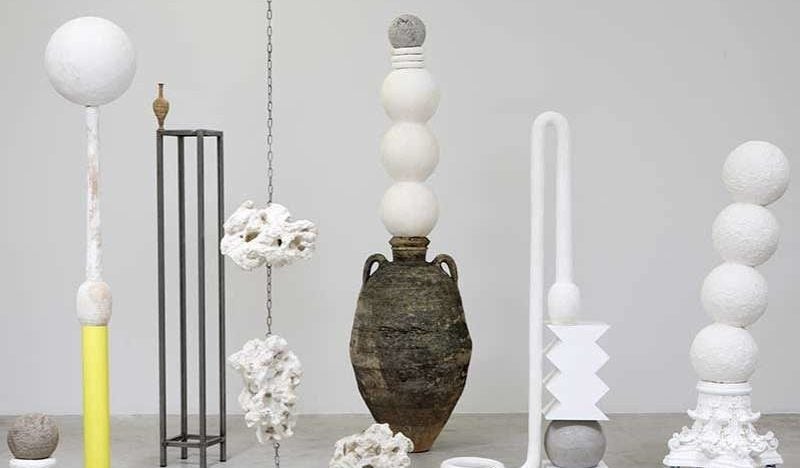Théo Mercier The Thrill is Gone

With the support of La Friche la Belle-de-Mai and the Fondation d’Entreprise Ricard.
Exhibition held as part of the 16th Actoral Festival in Marseilles.
Design: Marseilles Museum of Contemporary Art [mac], the Actoral Festival in association with the Bugada & Cargnel gallery, Paris.
The Thrill is Gone project was selected and supported by the Fondation Nationale des Arts Graphiques et Plastiques sponsorship scheme.
In his first individual exhibition in a French gallery, entitled The Thrill is Gone, Theo Mercier (born in Paris 1984, lives and works in Paris and Mexico) presents a combined exhibition of his latest series of sculpture and photographic work, which combine contemporary and archaeological remains suffused with a post-modernist and New Age aesthetic. The result is a journey through archaeology, current events and science fiction, invoking a sense of urgency in the face of the precariousness and obsolescence of objects, civilisations and beauty.
Between the rise and fall of objects and civilisations, Mercier fills a 1000m2 space with what looks like an imaginary wartime museum, a hoard of the spoils of war, a customs seizure cache. Each object exhibited encapsulates its end, its loss, its descent into oblivion, along with a political resonance. This feeling is all the more resonant as, in this project, the artist evokes a permeability between conservation and current events, between the museum interior (the past) and the outside world (the present, the future). The content of the exhibition echoes the world beyond its confines. This silent dialogue will be articulated by two actors who will talk in front of the works, by turns taking the voices of visitors, tour guides, arts correspondents, philosophers or anthropologists.
As they explore, exhibition visitors may encounter Goodyear tyres on plinths, lockets containing archaeological remains and other prehistoric fossils, creating a unique calendar, a wheel of time, the origins of the world in the contemporary age. Further on, they may happen upon a damaged totem or a pile of tattered African masks, the worse for wear after their journey across the Mediterranean, before coming across a battalion of baseball masks, empty faces, ready to charge. Equally they may come across a collection of aquarium stones, a bridge between fantastical abysses and the cosmos, they may try to steer a course through the huge ceramic jars piled weightlessly, the balance seeming perfectly unstable like so many monuments to the fall, souvenirs from the temples of Palmyra or the museum in Mosul. Their impossible balancing act suggests a link between their precariousness and that of the visitor, who might equally contemplate a skyline of CD storage towers, the symbolic city of a civilisation of obsolete items. An exhibition about disappearance, between history and oblivion, The Thrill Is Gone resonates as an acknowledgement, between splendour and decline, contemplation and impotence However by conferring onto objects the power to make us speak and to make us think, Mercier opens up routes to new possibilities.
As a visual artist and master of stagecraft, Mercier’s work examines the intersection of anthropology, ethnography geopolitics and tourism. Between choreographed scenes and material explorations, he combines creative and curatorial practices, through which he facilitates a burgeoning exchange between past, present and future, the animate and the inanimate, true and false, artisanal and industrial, sacred and profane, real and fiction.
Most of Mercier’s pieces arise from the anthropomorphising of objects: found objects, collections, stacks, collages or grafted items. They are usually created in series, creating communities of items young and old, male and female, through which he reveals and invents a touching social hierarchy, as in his collection of totems made in Mexico, his place of inspiration and creation, and entitled Craft Thoughts Wood Songs or Nowhere Bodies (2015). The latter highlights the importance of movement in Mercier’s work. Seen in the way he puts his pieces together, it is also evidenced in the way he creates them: he turns wood and ceramic items using a pottery wheel which he has made himself. He also uses stools which he sits on as he works, using them as plinths for his work, making the creative process an integral part of the final work.
In his Back to Basics and Gender Studies (2015) series, Mercier combines African dance masks with modified elements of Papuan masks such as ears and eyebrows, grafting on an undulating PVC nose, a symbol of the undulating bodies of dancers, making these objects into something between mask and instrument. In producing these hybrid, polymorphous, polyvocal and ambiguous items, whose origins and purpose are unclear, Mercier gives shape to a highly distinctive transcultural, transgeographic and transtemporal form of exoticism. This is highlighted through his mise en scene which constantly creates clashing resonances which shift between the cabinet of curiosities, treasure room, warehouse, workshop, group photograph and so on. Between real and fantastical anthropology, the artist takes on the mantle of the explorer, bringing back objects from real and nonexistent worlds, like so many pieces of evidence from journeys never taken.
Mercier attempts a thoroughgoing re-examination of the history of humanity and its production, which he compares to that made possible by the internet. However as his 2013 work recalls, La possession du monde n’est pas ma priorité, [Possessing the world is not my priority], making a collection of three hundred fake aquarium rocks (bought during his travels of the world) look like an astonishing imaginary geological sample collection, symbolising the creation of a fantastical natural world through a culture of mass (re)production. Just as he enjoys exploring the polyvocal status of his objects and their contrasting display, Mercier riffs endlessly on the confusion, the loss even, of the artist’s gesture in the work, a motif that also emerges in the way he stages his performance Radio Vinci Park.

